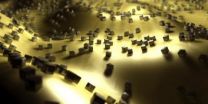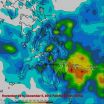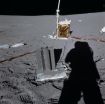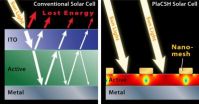(Press-News.org) Be careful what you eat, says University of Notre Dame stream ecologist Gary Lamberti.
If you're catching and eating fish from a Lake Michigan tributary with a strong salmon run, the stream fish — brook trout, brown trout, panfish — may be contaminated by pollutants carried in by the salmon.
Research by Lamberti, professor and chair of biology, and his laboratory has revealed that salmon, as they travel upstream to spawn and die, carry industrial pollutants into Great Lakes streams and tributaries. The research was recently published in the journal Environmental Science and Technology.
It's a problem inadvertently created by people with good intentions, he notes.
"Most people don't realize that salmon are a non-native species in the Great Lakes," he says. "They were introduced to control alewives — another non-native fish species."
Although salmon fed on and contained the alewives — and have become important to sport fishing—there were unintended consequences. That's because of a lengthy history of industrial pollution of the Great Lakes.
"All the Great Lakes have some level of pollution," says Lamberti, "especially near cities — Chicago, Detroit, Cleveland. There are far fewer pollutants now than over the past century, but many are persistent. There are hot spots, and Lake Michigan has a lot of them — heavy metals, mercury, organic pollutants like PCBs."
PCBs (polychlorinated biphenyls) come from fluids in older electrical transformers. Also present is DDE (dichlorodiphenyldichloroethylene), a breakdown product of the banned insecticide DDT, and PBDEs (polybrominated diphenyl ethers). PBDEs, notes Lamberti, are flame retardants used in furniture, mattresses and children's clothing. "They wash out when you do the laundry."
Brook trout with salmon eggs pumped from its stomach Brook trout with salmon eggs pumped from its stomach
Even intentionally introduced species such as the Pacific salmon can result in unintended consequences for the ecosystem and the environment.
Salmon acquire pollutants through the lake food chain. When they are young, they feed on invertebrates — worms and insect larvae. As they grow larger, salmon consume more and more fish, such as alewives — which have also picked up pollutants through invertebrates they eat, which have picked up pollutants from algae and bacteria.
Salmon are a fatty fish, and these polluting chemicals are particularly "sticky," Lamberti says. "They are lipophilic — they absorb into fat tissue."
The consequence is that the salmon magnify the pollutants as they move up the food chain. "Salmon are longer lived, eat more, and the pollutants are then bio-concentrated."
The concern is that salmon are naturalized to many tributaries of the Great Lakes. "And it's a one-way street for them," Lamberti says. "They spawn, die in the stream where they spawn, and then leave their contaminant load in the stream. Stream fish eat salmon eggs, and may also eat carcass tissue as they decompose."
Fish in streams and tributaries with large salmon runs — fish that never go out into the lake, he notes — show contaminant levels very similar to that of Great Lakes salmon.
"Let's keep in mind," he adds, "there are FDA advisories for pregnant women and children on the risks of eating large Great Lakes fish, because of the danger of chemical contaminants.
"But there are no warnings for stream fish — that's the specter. If you're eating fish from a stream with a lot of salmon, you might as well be eating the salmon. I would err on the side of caution when eating any fish from a salmon river. Either that or harvest fish only upstream of where salmon spawn."
For comparison purposes, Lamberti's research analyzed the tissue of fish upstream from where salmon spawn and die.
"The upstream section of the same river was not contaminated. Below the salmon, the river had measurable levels of contaminants. There's no other way for the contaminants to get there but the salmon. Water doesn't flow uphill."
The conclusion?
Although salmon are an economic benefit to the Great Lakes and perform important ecological functions (such as controlling the population of alewives), we need to consider the impact of salmon on streams where they spawn.
"If we want to remove a dam on a river — and that will allow salmon to move upstream — we need to realize that the salmon will carry pollutants with them and disperse them into the food web," Lamberti says.
"In sensitive areas with a lot of native fish, we might want to prevent salmon from moving upstream. And in the Great Lakes, maybe we should consider restoring the native populations of lake trout and whitefish rather than encouraging more salmon."
### END
Notre Dame research reveals migrating Great Lakes salmon carry contaminants upstream
2012-12-07
ELSE PRESS RELEASES FROM THIS DATE:
Silver nanocubes make super light absorbers
2012-12-07
DURHAM, N.C. -- Microscopic metallic cubes could unleash the enormous potential of metamaterials to absorb light, leading to more efficient and cost-effective large-area absorbers for sensors or solar cells, Duke University researchers have found.
Metamaterials are man-made materials that have properties often absent in natural materials. They are constructed to provide exquisite control over the properties of waves, such as light. Creating these materials for visible light is still a technological challenge that has traditionally been achieved by lithography, in which ...
NASA compiles Typhoon Bopha's Philippines Rainfall totals from space
2012-12-07
NASA's Tropical Rainfall Measuring Mission, or TRMM satellite can estimate rainfall rates from its orbit in space, and its data is also used to compile estimated rainfall totals. NASA just released an image showing those rainfall totals over the Philippines, where severe flooding killed several hundred people. Bopha is now a tropical storm in the South China Sea.
High winds, flooding and landslides from heavy rains with Typhoon Bopha have caused close to 300 deaths in the southern Philippines.
The TRMM satellite's primary mission is the measurement of rainfall in the ...
UC Davis study shows that treadmill testing can predict heart disease in women
2012-12-07
(SACRAMENTO, Calif.) — Although there is a widespread belief among physicians that the exercise treadmill test (ETT) is not reliable in evaluating the heart health of women, UC Davis researchers have found that the test can accurately predict coronary artery disease in women over the age of 65. They also found that two specific electrocardiogram (EKG) indicators of heart stress during an ETT further enhanced its predictive power.
Published in the December issue of The American Journal of Cardiology, the study can help guide cardiologists in making the treadmill test ...
TGen-US Oncology data guides treatment of metastatic triple-negative breast cancer patients
2012-12-07
PHOENIX, Ariz. — Dec. 6, 2012 — Genomic sequencing has revealed therapeutic drug targets for difficult-to-treat, metastatic triple-negative breast cancer (TNBC), according to an unprecedented study by the Translational Genomic Research Institute (TGen) and US Oncology Research.
The study is published by the journal Molecular Cancer Therapeutics and is currently available online.
By sequencing, or spelling out, the billions of letters contained in the genomes of 14 tumors from ethnically diverse metastatic TNBC patients, TGen and US Oncology Research investigators found ...
General thoracic surgeons emerge as leading providers of complex, noncardiac thoracic surgery
2012-12-07
While thoracic surgeons are traditionally known as the experts who perform heart surgeries, a UC Davis study has found that general thoracic surgeons, especially those at academic health centers, perform the vast majority of complex noncardiac operations, including surgeries of the esophagus and lungs.
The authors said their results, published in the October issue of The Annals of Thoracic Surgery, support the designation of general thoracic surgery as a distinct specialty, which will benefit patients when selecting surgeons for specific procedures.
"In years past, ...
Apollo's lunar dust data being restored
2012-12-07
Forty years after the last Apollo spacecraft launched, the science from those missions continues to shape our view of the moon. In one of the latest developments, readings from the Apollo 14 and 15 dust detectors have been restored by scientists with the National Space Science Data Center (NSSDC) at NASA's Goddard Space Flight Center in Greenbelt, Md.
"This is the first look at the fully calibrated, digital dust data from the Apollo 14 and 15 missions," said David Williams, a Goddard scientist and data specialist at NSSDC, NASA's permanent archive for space science mission ...
December 2012 Story Tips
2012-12-07
DISASTER RESPONSE – Limiting access . . .
Ensuring that only people who have legitimate business are allowed to enter areas hit by floods, hurricanes or other disasters is a big challenge, but Credentialing 2.0 offers a software solution. "Obviously, first responders, utility crews, tree cutters, disaster relief workers and members of the media have reasons to be on the scene, but there's no efficient way to control access," said Oak Ridge National Laboratory's David Resseguie, who leads the Credentialing 2.0 development team. The ORNL system helps officials to control ...
Combining two genome analysis approaches supports immune system contribution to autism
2012-12-07
Researchers using novel approaches and methodologies of identifying genes that contribute to the development of autism have found evidence that disturbances in several immune-system-related pathways contribute to development of autism spectrum disorders. The report published December 4 in the open-access journal PLOS ONE powerfully supports a role for the immune function in autism by integrating analysis of autism-associated DNA sequence variations with that of markers identified in studies of families affected by autism.
"Others have talked about immune function contributions ...
Tiny structure gives big boost to solar power
2012-12-07
Princeton researchers have found a simple and economic way to nearly triple the efficiency of organic solar cells, the cheap and flexible plastic devices that many scientists believe could be the future of solar power.
The researchers, led by electrical engineer Stephen Chou, were able to increase the efficiency 175 percent by using a nanostructured "sandwich" of metal and plastic that collects and traps light. Chou said the technology also should increase the efficiency of conventional inorganic solar collectors, such as standard silicon solar panels, although he cautioned ...
Valuable tool for predicting pain genes in people
2012-12-07
Scientists in Australia and Austria have described a "network map" of genes involved in pain perception, with remarkable similarity from fruit flies to people. The work should help identify new analgesic drugs.
Dr Greg Neely from the Garvan institute of Medical Research in Sydney and Professor Josef Penninger from the Austrian Academy of Sciences in Vienna had previously screened the 14,000 genes in the fly genome and identified 580 genes identified with heat perception. In the current study, using a database from the US National Centre for Biotechnology Information, ...



